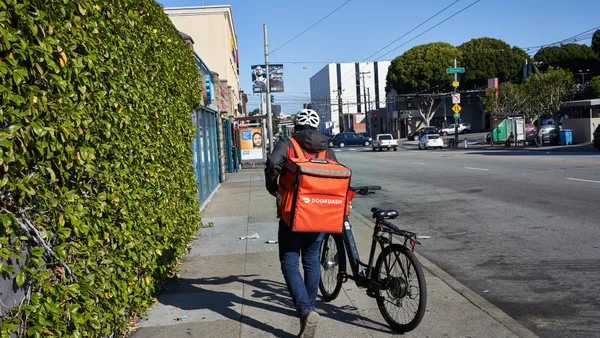Dive Brief:
- A new report from SevenRooms finds that nearly half of all consumers (48%) believe it's cheaper to order directly from a restaurant than through a third-party delivery platform.
- Sixteen percent of diners believe third-party platforms do more harm than good for restaurants, 23% feel that delivery aggregators charge too much in fees from restaurants and 37% are motivated to order directly from operators to support restaurants.
- SevenRooms data also finds that restaurants have done more work in the past year to incentivize consumers to order directly. Twenty-eight percent of diners say they would be incentivized to order takeout directly versus via a third-party platform if they were offered a personalized promotion, such as a discount code or complimentary item.
Dive Insight:
More than 110,000 restaurants have closed throughout the past year, which is sparking consumer awareness of the challenges the industry faces and motivating diners to help support operators. Of the consumers motivated to order directly from a restaurant, 28% said it's because they have seen their favorite restaurants struggle and want to help them as much as possible, according to SevenRooms research.
Third-party delivery platforms take a 30% commission from restaurants on average, according to Seven Rooms. Throughout the past year, several cities launched initiatives to help restaurants protect their margins as they operated under takeout- and delivery-only restrictions, including delivery fee caps in Seattle, New York and Los Angeles. Restaurant groups including the Iowa Restaurant Association also encouraged people in March to order directly from their favorite restaurant instead of third-party services to help in the industry's recovery.
During 2020, many major delivery aggregators temporarily waived or reduced commission fees for delivery or takeout to attract new restaurant partners and deepen loyalty with existing operators in their networks. DoorDash was especially proactive in drumming up diner support for restaurants on its platform, creating app filters highlighting Black-owned businesses, creating free delivery promotions for local restaurants to entice diners and launching a five-year, $200 million "Main Street Strong" pledge to dedicate investments, programs, products, service and benefits to support partner restaurants.
Still, SevenRooms report suggests that creating a direct ordering solution could have a major financial impact on restaurants. For example, the restaurant reservation system estimates that a direct ordering solution would save roughly $54,000 for a high-end New York Italian restaurant that generates $216,000 in delivery orders in a six-month period.
Even legacy restaurant chains that have the power to negotiate lower commission fees are incentivizing diners to order directly from their digital platforms. Shake Shack, for example, launched its in-app delivery nationwide last week through a white label partnership with Uber Eats. Burger King's loyalty program is providing points for ordering through its app or website as well. These moves could create a shift in consumer habits away from third-party marketplaces, and help restaurants own their diners' valuable personal data.
"Now these guests are in our ecosystem and we know who they are and what they like, and we can begin to personalize their menus to make it a more delightful experience," Shake Shack CMO Jay Livingston told Business Insider about the company's app in December.
That said, the third-party delivery channel isn't going away. All of the major delivery providers now offer a white-label solution, which could facilitate more direct ordering and solve for the growing number of consumers looking for a direct ordering channel, but would still involve commission fees.









